|
|
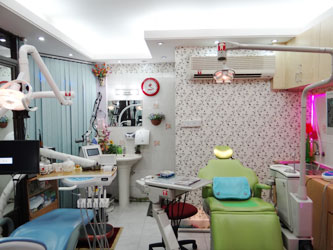 Welcome to Dr. Rifat's Practice
Welcome to Dr. Rifat's Practice
The National Health Service available in Bangladesh is a basic and inexpensive service which aims to keep you reasonably dentally and medically fit. Its structure and funding do not extend beyond that basic defined aim. Thus there are limitations to NHS care.
Private dentistry has no such limitations and the dentist and patient are free to develop a treatment plan that is best for the individual patient and reflects their needs and pocket
The role of lasers in surgery has been expanding ever since buy pregabalin their first use in medicine to treat disease of the retina in 1967. Initially the rate of take-up by surgeons was slow, as old habits die hard. Now, with many different surgical laser systems offered, their use is becoming commonplace. Technology is changing on an almost weekly basis, and laser users need to be at the very front of their field to take full advantage of this. The use of lasers in Cosmetic Surgery, Dental Surgery, Ear, Nose and Throat (ENT) surgery is now commonplace, it is this specialism, along with eye surgery, which uses laser technology in surgery the most.
 There are now ideal lasers for most applications in Cosmetic surgery and in many cases the correct laser in the correct clinical situation offers significant advantages to the patient over standard non-laser methods. It is at these specific areas that the Rifat's Cosmetic Laser Care is aimed.
There are now ideal lasers for most applications in Cosmetic surgery and in many cases the correct laser in the correct clinical situation offers significant advantages to the patient over standard non-laser methods. It is at these specific areas that the Rifat's Cosmetic Laser Care is aimed.
The Rifats Dental Implant Laser Cosmetic Care has been proposed and developed by Dr. G K M Rifatullah and Dr. Nabanita Chakraborty, all of whom have particular skills in their own fields. Surgeons affiliated to the clinic are either trained internationally or be particular experts in their own field of laser surgery. The aim is to provide a high quality service to remaining independent from all other laser users in Rifats Laser Cosmetic Care.
The Rifats Laser Care has access to the best types of 3 rd Generation lasers for each of the procedures performed. These procedures are offered on the basis that in each instance, the use of a laser is directly beneficial to the patient. Some other non-laser operations performed in Cosmetic Surgery are also offered, since technological advances in these areas also give a benefit to patients over old-fashioned surgery. The number of procedures offered is expanding as technology advances. The main direction of the clinic's surgery is in Cosmetic and facial plastics. 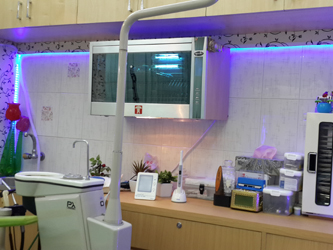
The Rifat's Dental Implant Laser Cosmetic Care will concentrate on day case surgery in this area, with the emphasis being on a high quality service minimizing disruption to the patient's lifestyle. This includes a streamlined approach to consultation, treatment and postoperative care.
Why Lasers?
Lasers in medicine use the physical fact that a light beam carries energy. If this energy is of the correct wavelength and intensity, change can be caused to living tissue, the degree of change being proportional to the amount of absorption of light by each individual tissue component. This absorption of light depends on the optical properties of each separate component of tissue, and the wavelength of light being transmitted to the tissue. Different tissues therefore absorb light of different wavelengths maximally. The aim is to select the wavelength of light that is best suited to treat the tissue that requires treatment.
Laser energy can also be very delicately delivered due to accurately focused lenses or small diameter fibres (down to 200 microns). Laser light can also be short pulsed (less than 1 millisecond) by computer control of the beam, reducing unwanted damage. Due to these facts alone or in combination, diseased tissue can be removed whilst reducing normal tissue damage, in some cases diseased tissue can be treated with almost no normal tissue damage.
Lasers also have the ability to stop bleeding simultaneously with a cutting action, allowing rapid, bloodless operations, reducing anaesthetic time. This leads to a quick recovery, and often little pain in the early postoperative period. This is a very useful advantage when performing surgery as a day case, which all of the Clinic's operations are designed to be.
Types of Lasers & Use :
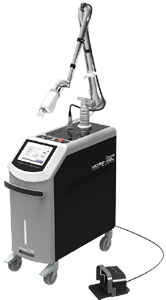 Carbon Dioxide (CO2): This system involves the production of laser light from a gas medium that is mostly CO2 as found in the atmosphere. Light can be delivered in a very delicate manner, either by fine pulsing or scanning. Because there is minimal absorption of light at this wavelength (10,600 nanometres), very accurate removal of tissue is possible. The CO2 laser is the workhorse of most Cosmetic laser surgery. At RDLC we use this laser for cosmetic skin surgery and several other procedures.
Carbon Dioxide (CO2): This system involves the production of laser light from a gas medium that is mostly CO2 as found in the atmosphere. Light can be delivered in a very delicate manner, either by fine pulsing or scanning. Because there is minimal absorption of light at this wavelength (10,600 nanometres), very accurate removal of tissue is possible. The CO2 laser is the workhorse of most Cosmetic laser surgery. At RDLC we use this laser for cosmetic skin surgery and several other procedures. The Art & Technology of Lasers:
Laser surgery is widely applied in a variety of human surgical specialties such as: otolaryngology, gynecology, neurosurgery, plastic surgery, dermatology and oral & maxillofacial surgery. Out of several laser types available, the CO2 laser is considered the "workhorse" of laser surgery due to its unique capabilities in performing precise, hemostatic incisions, excisions and ablations of tissue.
The CO2 laser emits continuous or pulsed infrared radiation which is highly absorbed in water. Since any soft tissue is composed mainly of water, tissue at the focal point of the laser beam is instantaneously vaporized, leaving behind a thin necrotic layer of tissue which assures homeostasis.
On humans, CO2 laser surgery is implemented in the freehand mode, in microsurgery and in rigid endoscopy, enabling surgical precision to a fraction of a millimeter.
CO2 surgical lasers for human surgery are installed in thousands of hospitals and clinics around the world. These systems have so far been too large and too expensive for the average clinic. The 3 rd Generation Bison CO2 surgical laser now offers medical practitioners the advantages of CO2 laser surgery in a compact and affordable system.
How it works?
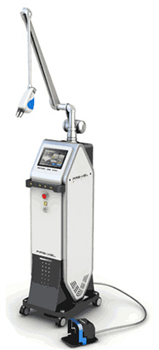 The wavelength emitted by a CO2 laser is 10,600 nanometers (nm). This wavelength is in the far infrared spectrum and is invisible to the human eye. Water has extremely high absorption at this wavelength. A 30 micron thin layer of water will absorb 90% of CO2 laser radiation, and only 10% will pass through. Since 75-95% of soft tissue is composed of water, this wavelength is highly absorbed in soft tissue and therefore highly effective in vaporizing soft tissue, regardless of color. Tissue vaporization is instantaneous with very
The wavelength emitted by a CO2 laser is 10,600 nanometers (nm). This wavelength is in the far infrared spectrum and is invisible to the human eye. Water has extremely high absorption at this wavelength. A 30 micron thin layer of water will absorb 90% of CO2 laser radiation, and only 10% will pass through. Since 75-95% of soft tissue is composed of water, this wavelength is highly absorbed in soft tissue and therefore highly effective in vaporizing soft tissue, regardless of color. Tissue vaporization is instantaneous with very 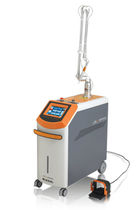 minimal surrounding thermal necrosis which aids in hemostasis. The spectral absorption of water also provides the CO2 laser with the ability to coagulate, cut, or char, tissue depending on the power density and the energy level applied by the surgeon. When the laser beam is focused, the laser can cut like a scalpel, but when the laser is defocused the laser vaporizes the soft tissue.
minimal surrounding thermal necrosis which aids in hemostasis. The spectral absorption of water also provides the CO2 laser with the ability to coagulate, cut, or char, tissue depending on the power density and the energy level applied by the surgeon. When the laser beam is focused, the laser can cut like a scalpel, but when the laser is defocused the laser vaporizes the soft tissue.
The surgeon can control the extent by which the laser beam is absorbed into surrounding tissue, resulting in an extremely precise tissue incision. To minimize heat transfer to surrounding tissue and reduce collateral heat damage, the duration of laser beam on the tissue can be controlled (usually less than 1 millisecond). To allow precise positioning of the surgical laser beam, an additional red, low power laser beam is incorporated in the system so that both beams are coincident at the surgical site.
Benefits
1. Pain Reduction
Patients will experience considerably less postoperative pain in almost every instance. This reduction in pain is a result of the unique characteristics of the laser beam as it cuts nerve endings, preventing the raw ends typical to scalpel incisions. The CO2 laser seals nerve endings as it "cuts", so your patient will likely require less anesthesia during the operation, and enjoy easier recuperation.
2. Swelling Reduction
Whenever an incision is made in the tissue with either a scalpel blade or scissors, inflammation begins in the affected tissue. This inflammation is a result of interaction with the circulatory and lymphatic systems. Because the laser beam effectively cauterizes the lymphatic system, there is much less postoperative swelling. In addition, laser energy does not crush, tear, or bruise tissue since there is no physical contact with the tissue. Postoperative Recovery is faster and the patient experiences more comfort.
3. Control of Infection
Since laser beam operates at a temperature of over 200 degrees Fahrenheit; it is highly effective at killing bacteria that have the potential to cause an infection. In fact, this is particularly important in areas in which it is difficult to prevent contamination of the surgical site. The CO2 laser sterilizes the infected area as it removes diseased tissue, leaving healthy tissue undamaged. Because the sterilization process is so effective, the use of antibiotics is substantially reduced.
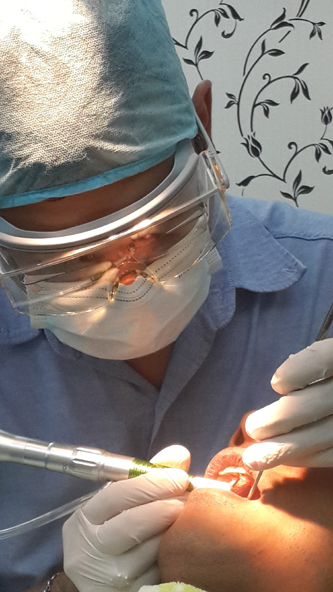 4. Minimal Surgical Bleeding
4. Minimal Surgical Bleeding
When an incision is made with a scalpel blade, blood vessels in the area are severed, and can ooze during and after the surgery. Traditionally this is controlled by clamping the torn vessels with hemostats, cauterizing the vessel using electro-surgery, or holding gauze sponges until the bleeding stops. All of these procedures take time, which means the surgery takes longer and there is more postoperative swelling. The laser seals small blood vessels as it cuts, reducing or completely eliminating the need for any other bleeding control measures. This means less time is required for the surgical procedure and, usually, reduced need for anesthesia.
5. Hospitalization and Healing Time
With laser surgery, healing is rapid and there is less postoperative discomfort. Laser procedures provide reduced trauma and less invasive surgeries for patients, improve recovery time, and shorten time spent in the hospital. No tissue reaction (edema) is usually noted. The laser allows destruction of diseased tissue while preserving normal tissue. Post surgical scarring is also reduced.
6. Greater Accuracy & Precision
The laser can remove diseased tissue without affecting surrounding healthy tissue. Not only does the blood-free cutting benefit the patient, it also provides a clear, dry surgical field for the surgeon. The lack of bleeding improves the surgeon's visual control of the procedure because he can clearly see the different tissue layers. As a result, the surgeon is able to enhance surgical precision.
Portfolio
Chief Consultant at Rifat's Dental & CMD Clinic,
39 New Elephant Road, Kazi Bhaban, Dhaka-1205, Bangladesh. Ph: +88 02 8650988, +88 01819 2782299
Attend dental patients as routine works.
Investigate primary oral & dental disease & seek other pathology.
Advice X-ray ( Intraoral views periapical radiograph, bitewing, extra oral projections panoramic / OPG & other x-rays ), based on neglected / bad oral & teeth conditions, poor localization of pain, heavily restored teeth & ill define patients.
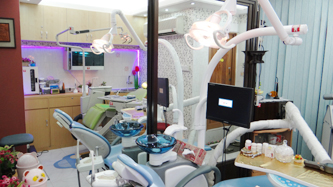 Other diagnostic measures are taken according to patients health conditions ( Such as diabetic, thalassemic, haemophilic, patients with hepatitis, bleeding disorder, high/low blood pressure, patient at high risk )
Other diagnostic measures are taken according to patients health conditions ( Such as diabetic, thalassemic, haemophilic, patients with hepatitis, bleeding disorder, high/low blood pressure, patient at high risk )
Special attentions are taken for appropriate clinical diagnosis & safety precautions for the above mentioned patients.
Diagnose the appropriate conditions of patients.
Suggest proper treatment after examining actual condition.
Advise medicine pre-operatively if necessary ( e.g; palliative drug therapy for acute oral infections )
 |
 |
 |
 |